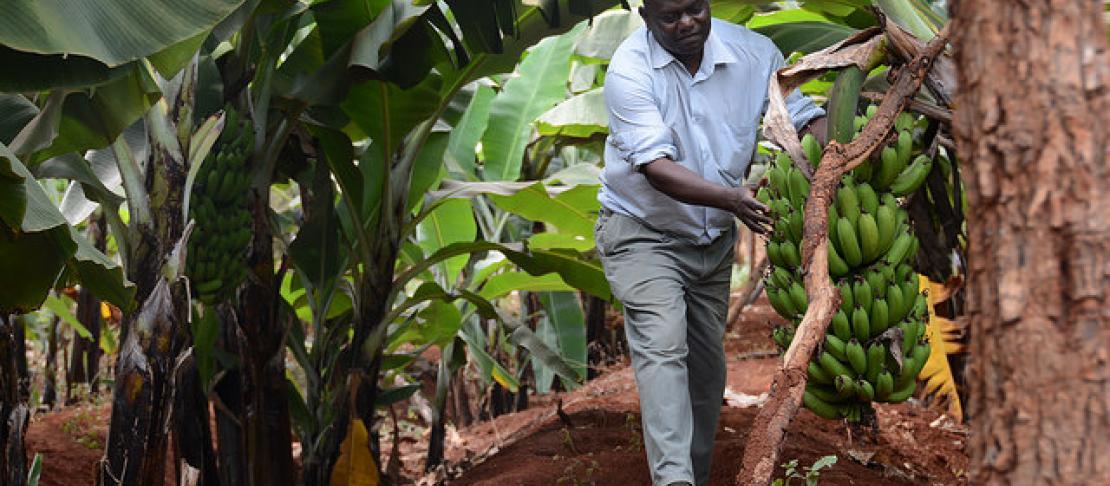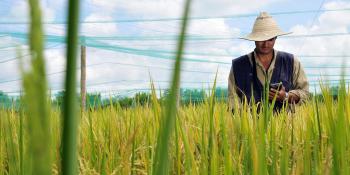Addressing priority adaptation measures in Uganda

Agricultural priority actions to address adaptation in Uganda must be well informed and aligned with available resources and policies and Uganda’s Vision 2040.
Uganda is highly vulnerable to climate change and variability – its economy and the wellbeing of its people are tightly bound to the climate. With a rapidly growing population (annual 3.2%) that needs to be fed, the impacts of climate change will further exacerbate the problems of food insecurity, poverty and weak social institutions. Early adaptation to climate change can moderate impacts of climate and even secure benefits to families. Therefore, Uganda developed the National Adaptation Programmes of Action (NAPAs) in 2007 to climate-proof development. Agricultural stakeholders in the country identified some key areas in their NAPAs to cushion the country from population growth and climate change effects.
The NAPA implementation process so far
Uganda’s NAPA identified the following nine priority sectors:
- Community Tree Growing
- Land Degradation Management
- Strengthening Meteorological Services
- Community Water and Sanitation
- Water for Production
- Drought Adaptation
- Vectors, Pests and Disease Control
- Indigenous Knowledge (IK) and Natural Resources Management
- Climate Change and Development Planning
The implementation of these priorities has been slow with a number of organizations facing challenges due to overlapping of projects and minimal support from key stakeholders.
Read more on challenges in developing adaptation plans
Collaboration needed
Based on this, the CGIAR Research Program on Climate Change, Agriculture and Food Security (CCAFS) and the Climate Change Unit, Ministry of Water and Environment (CCU-MWE) organized a two day workshop to bring together stakeholders from government, research institutions, civil society, farmer organizations and private sector to dialogue and identify key thematic areas for partnership and collaboration and to discuss key investment areas for the agricultural sector informed by the NAPA.
“We need to increase collaborations with different institutions because climate change impacts all sectors. This will make us more accountable to our communities,” said Mr. Mutabazi Sunday from the Ministry of Agriculture Animal Industry and Fisheries (MAAIF).
During the meeting, participants noted that strong leadership with the power to influence implementation of agriculture priority actions is required to respond effectively to climate change. Even though the Climate Change Unit housed within the Ministry of Water and Environment is mandated to spearhead climate change initiatives, at the moment that leadership and capacity (in terms of resources and personnel) is lacking. CCAFS has previously supported the identification of priority actions for implementation in the agriculture sector in Kenya’s 2013 – 2017 National Climate Change Action Plan (NCCAP).
Read more: Kenya holds first national adaptation planning meeting for agriculture

PARTICIPANTS ENGAGE IN GROUP DISCUSSIONS DURING THE NAPA MEETING. photo: s. KILUNGU
Mr. Chebet Maikut, the Deputy Coordinator at the Climate Change Unit, informed participants that NAPA pilot activities have started in four agro-ecological zones in the country with support from the Royal Danish Embassy.
“Lessons learnt and early actions on addressing priority adaptation measures in the most vulnerable communities will help to inform policy and strategy as well as leverage additional resources”, said Chebet Maikut.
However, according to Mr Mutabazi, there is need to upscale the pilot projects in all 120 districts in the country. Such pilot projects include water harvesting and micro irrigation, climate-smart crop and livestock interventions among others. Upscaling will create an excellent opportunity for multi-stakeholder collaboration to implement agricultural actions that can respond to climate change.
Way forward
As a way forward, participants at the workshop recommended that the CCU undertakes an inventory of climate change adaptation and mitigation agricultural projects and activities by various actors and assess elements of community climate resilience with a view of making the projects aligned to Uganda’s NAPA and Vision 2040. Additionally participants recommended the development of a comprehensive communication strategy which could be used to share the lessons learnt from the pilot projects.
Additional Reading
For more information regarding CCAFS policy engagement in Kenya and beyond see:
Climate adaptation and agriculture: Solutions to successful national adaptation plans
Addressing climate change at the policy level
The serious business of NAP-ing
National Adaptation Plans in agriculture: a work in progress
This blog story was written by Catherine Mungai (Research Technician), Solomon Kilungu (Communication Assistant) and Mary Nyasimi (Gender and Policy Specialist) from CCAFS EA.
For more information about CCAFS work in East Africa visit our webpage and follow @cgiarclimate_EA on twitter.



